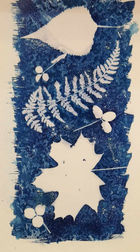

DANIEL DUGAS
CARAQUET, NB.
Photographer Daniel Dugas holds a BFA in photography from Concordia University.
He uses analogous photographic processes, such as wet collodion, a technique invented in 1851. Using a century-old camera, he also made cyanotypes, a technique invented in 1842. Sometimes, he combines these two techniques to produce an original final image.
Using the wet collodion technique, he likes to photograph landscapes in which the theme of the sea is often present.
When he uses the cyanotype technique, he sometimes prints wet collodion plates or plants and foliage on contact drawing paper. These two techniques enable him to create images full of character, with an aesthetic that the photographer is particularly fond of.
Wet collodion photography is a rather temperamental and challenging technique, which means that very few people practise it today. "But that's precisely what gives me the satisfaction and, above all, the merit of having succeeded with an image, unlike digital photography which, because it's so easy and lacking in processes, gives me no pleasure whatsoever. I really feel I'm practising photography in its purest form.
Also, these are techniques where you have to take your time. In a world where everything moves so fast, it forces me to slow down and appreciate the time spent making images."




